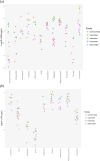Mixed phylogenetic signal in fish toxicity data across chemical classes
- PMID: 29676862
- PMCID: PMC6016386
- DOI: 10.1002/eap.1698
Mixed phylogenetic signal in fish toxicity data across chemical classes
Abstract
Chemical use in society is growing rapidly and is one of the five major pressures on biodiversity worldwide. Since empirical toxicity studies of pollutants generally focus on a handful of model organisms, reliable approaches are needed to assess sensitivity to chemicals across the wide variety of species in the environment. Phylogenetic comparative methods (PCM) offer a promising approach for toxicity extrapolation incorporating known evolutionary relationships among species. If phylogenetic signal in toxicity data is high, i.e., closely related species are more similarly sensitive as compared to distantly related species, PCM could ultimately help predict species sensitivity when toxicity data are lacking. Here, we present the largest ever test of phylogenetic signal in toxicity data by combining phylogenetic data from fish with acute mortality data for 42 chemicals spanning 10 different chemical classes. Phylogenetic signal is high for some chemicals, particularly organophosphate pesticides, but not necessarily for many chemicals in other classes (e.g., metals, organochlorines). These results demonstrate that PCM may be useful for toxicity extrapolation in untested species for those chemicals with clear phylogenetic signal. This study provides a framework for using PCM to understand the patterns and causes of variation in species sensitivity to pollutants.
Keywords: ecological risk assessment; ecotoxicology; evolutionary toxicology; fish; organochlorine; organophosphate; phylogenetic comparative methods; phylogeny.
© 2018 by the Ecological Society of America.
Figures


Similar articles
-
Phylogeny predicts sensitivity in aquatic animals for only a minority of chemicals.Ecotoxicology. 2024 Oct;33(8):921-936. doi: 10.1007/s10646-024-02791-7. Epub 2024 Jul 22. Ecotoxicology. 2024. PMID: 39037520 Free PMC article.
-
Transferring knowledge across aquatic species via clustering techniques to unravel patterns of pesticide toxicity.Sci Total Environ. 2024 Nov 10;950:175385. doi: 10.1016/j.scitotenv.2024.175385. Epub 2024 Aug 8. Sci Total Environ. 2024. PMID: 39122048
-
Comparative analysis of toxicity sensitivity and functional traits in fish.Aquat Toxicol. 2025 Aug;285:107432. doi: 10.1016/j.aquatox.2025.107432. Epub 2025 May 31. Aquat Toxicol. 2025. PMID: 40466286
-
Bioconcentration, bioaccumulation, and metabolism of pesticides in aquatic organisms.Rev Environ Contam Toxicol. 2010;204:1-132. doi: 10.1007/978-1-4419-1440-8_1. Rev Environ Contam Toxicol. 2010. PMID: 19957234 Review.
-
A review of the effects of multiple stressors on aquatic organisms and analysis of uncertainty factors for use in risk assessment.Crit Rev Toxicol. 2001 May;31(3):247-84. doi: 10.1080/20014091111695. Crit Rev Toxicol. 2001. PMID: 11405441 Review.
Cited by
-
Phylogeny predicts sensitivity in aquatic animals for only a minority of chemicals.Ecotoxicology. 2024 Oct;33(8):921-936. doi: 10.1007/s10646-024-02791-7. Epub 2024 Jul 22. Ecotoxicology. 2024. PMID: 39037520 Free PMC article.
-
Correcting for Phylogenetic Autocorrelation in Species Sensitivity Distributions.Integr Environ Assess Manag. 2020 Jan;16(1):53-65. doi: 10.1002/ieam.4207. Epub 2019 Nov 18. Integr Environ Assess Manag. 2020. PMID: 31433110 Free PMC article.
-
Sialic acid on avian erythrocytes.Comp Biochem Physiol B Biochem Mol Biol. 2019 Dec;238:110336. doi: 10.1016/j.cbpb.2019.110336. Epub 2019 Aug 30. Comp Biochem Physiol B Biochem Mol Biol. 2019. PMID: 31476363 Free PMC article.
-
Elevated metallothionein expression in long-lived species mediates the influence of cadmium accumulation on aging.Geroscience. 2021 Aug;43(4):1975-1993. doi: 10.1007/s11357-021-00393-3. Epub 2021 Jun 11. Geroscience. 2021. PMID: 34117600 Free PMC article.
References
-
- Ankley GT, Bennett RS, Erickson RJ, Hoff DJ, Hornung MW, Johnson RD, Mount DR, Nichols JW, Russom CL, Schmieder PK, et al. Adverse outcome pathways: A conceptual framework to support ecotoxicology research and risk assessment. Environ Toxicol Chem. 2010;29:730–741. - PubMed
-
- Backhaus T, Snape J, Lazorchak J. The impact of chemical pollution on biodiversity and ecosystem services: the need for an improved understanding. Integr Environ Assess Manag. 2012;8:575–576. - PubMed
-
- Barron MG, Lilavois CR, Martin TM. MOAtox: A comprehensive mode of action and acute aquatic toxicity database for predictive model development. Aquat Toxicol. 2015;161:102–107. - PubMed
-
- Buchwalter DB, Luoma SN. Differences in Dissolved Cadmium and Zinc Uptake among Stream Insects: Mechanistic Explanations. Environ Sci Technol. 2005;39:498–504. - PubMed
Publication types
MeSH terms
Substances
Grants and funding
LinkOut - more resources
Full Text Sources
Other Literature Sources
Medical

